|
|
|
Sort Order |
|
|
|
Items / Page
|
|
|
|
|
|
|
| Srl | Item |
| 1 |
ID:
164021
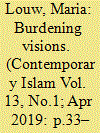

|
|
|
|
|
| Summary/Abstract |
Taking an ethnographic point of departure in the relationship between two women in Bishkek, the capital of Kyrgyzstan – a doctor and a clairvoyant – the article will focus on the ambiguous ways the visible and the invisible intersect in the lives of the Kyrgyz. Esoteric experiences such as ayan, dream omens, sometimes stand out as flashes of insight which bring clarity and guidance, but are equally often unwanted disturbances which haunt people against their will. In order to do justice to this ambiguity I engage the phenomenology of the alien as developed by Bernhard Waldenfels, arguing that esoteric experiences may be seen as an example of what he terms radical alienness which cast doubt on interpretation itself.
|
|
|
|
|
|
|
|
|
|
|
|
|
|
|
|
| 2 |
ID:
164022
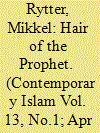

|
|
|
|
|
| Summary/Abstract |
This paper explore the politics of (in)visibility in Islam by discussing the affective presence and agency of relics - in this case a single hair of the Prophet Muhammad. The relic is obviously not the Prophet, but it is also not-not the Prophet, as the hair is filled with the baraka (blessings) of the Prophet and thereby seems to confirm Sir James Frazer’s thesis of ‘sympathetic magic’ where part and wholes are forever connected. Based on a study of the Naqshbandi Mujaddidi Saifi tariqa, this paper set out to ‘follow the hair’ in different settings in Denmark, Norway and Pakistan in order to discuss how it connects the visible and the invisible aspects of reality. I argue that the relic not only constitutes an affective presence of the beloved, but also that it becomes a significant agent in the establishment of an enchanted subaltern counter-public within Danish secular society.
|
|
|
|
|
|
|
|
|
|
|
|
|
|
|
|
| 3 |
ID:
164024
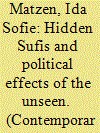

|
|
|
|
|
| Summary/Abstract |
Based on ethnographic fieldwork in Lahore, Pakistan, this article explores the political effects of the activities of hidden Sufi saints. In Pakistan, hidden Sufis are often said to intervene in worldly affairs (for example, in the killing of Osama bin Laden). Analyzing the wider cosmological background for claims to Sufi supremacy and power, I show how unseen—or in fact ‘supremely visible’—domains outstrip the visible world. In doing so, I examine how Sufi followers draw on esoteric knowledge to create what is in effect a political theory to analyze the violent present of opposition and terror attacks. Contrary to a general notion of Pakistani Sufis as inherently apolitical, the article thus offers an account of Sufi protection and spiritual governance as instances of ‘cosmological activism.’ To appreciate local Sufi theorizing and practices as expressions of immanent political modalities of Pakistani Sufism, I attend to my interlocutors’ versions of the Sufi principle of the ‘oneness of existence’ (wahdat al-wujud) as a potential anthropological analytics.
|
|
|
|
|
|
|
|
|
|
|
|
|
|
|
|
| 4 |
ID:
164026


|
|
|
|
|
| Summary/Abstract |
In this article I apply film theory as an analytic prism through which to examine the ritual mechanisms of a particular kind of Islamic exorcism (al-ruqya al-sharʿiyya). I show how these exorcisms operate as a ritual montage that conjures the absent presence of al-ghayb—a hidden world of power that only God can see in its totality and to which the possessed patients and the jinn spirits must succumb. These exorcisms thus provide healing, not in the sense of immediate “well-being” or “relief from pain” but in the sense of moral witnessing, an opportunity to testify to the limits of human seeing and action and to the ways in which invisible and divine forces give shape to the tangible world.
|
|
|
|
|
|
|
|
|
|
|
|
|
|
|
|
| 5 |
ID:
164023
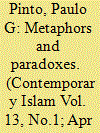

|
|
|
|
|
| Summary/Abstract |
Based fieldwork in Aleppo between 1999 and 2010, this article analyzes how secrecy and revelation, two forms of codification, maintenance and transmission of religious knowledge central to the mystical tradition of Sufism in contemporary Syria were constructed and enacted in the process of initiation (tarbiyya) into the mystical path in two Sufi zawiyas (ritual lodges) in pre-war Aleppo. Access to the unseen spheres of divine reality through initiation created both structures of charismatic power in the Sufi communities and religious subjectivities that empowered its holders as moral agents in the pre-civil war Syrian public sphere. I argue that Sufi practices of initiation that gradually revealed the divine reality to students while simultaneously also enhanced the mystery of this reality enabled Sufi practitioners to cope with the opacity of power and contradictions of everyday life of late-Ba‘thist modernity in Syria.
|
|
|
|
|
|
|
|
|
|
|
|
|
|
|
|
| 6 |
ID:
164018
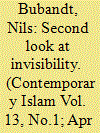

|
|
|
|
|
| Summary/Abstract |
The Arab concept al-ghayb refers to the hidden, the unseen, the invisible. The term encompasses a range of important phenomena in Islam and in the everyday experiences of Muslims. The dominion of the unseen (alam al-ghayb) includes those parts of reality that cannot be seen simply because they are covered by other visible objects. It also refers to those phenomena that by their nature cannot be perceived (e.g. the face or throne of God, paradise, hell, the past, or the future), as well as those objects that are blocked from view by one’s perspective (Drieskens 2006; Mittermaier 2011; Suhr 2013). Al-ghayb is important to the notion of barzakh, the intermediary realm between life and death; to the issue of veiling; to visions of deceased saints or dreams about the Prophet Muhammad as well as to the uncontrollable powers of jinn, angels, magic, the evil eye, and omens (Pandolfo 1997;
|
|
|
|
|
|
|
|
|
|
|
|
|
|
|
|
| 7 |
ID:
164025


|
|
|
|
|
| Summary/Abstract |
Spirits hold a central but ambivalent position in Indonesian political and social life. Pushed to the margins of public discourse in recent decades by modernism and Muslim piety, spirits remain key to the realm of the invisible or inscrutable (gaib) and continue to have a strong hold on the popular imagination in communities and on TV screens across the archipelago. One kind of spirit combines imagined potential and public ambivalence with particular force: jin spirits (also spelt jinn). Described in the Koran as real spiritual entities with an unfortunate habit of possessing humans, jin spirits are today also associated with heretical forms of Islam for many people with pious Muslim sensibilities and with backward superstition and evil magic for those with modern, secular sensibilities. Dealing with jin spirits, as a result, is always a careful negotiation with these cross-cutting sensibilities. This paper follows Kyai Muzakkin, the leader of an Islamic boarding school or pesantren in East Java, who insists that the one thousand jin spirits at his pesantren are real and effective “tools” at his disposal. I suggest that Kyai Muzakkin’s insistence on spirits as “tools” responds to the repressed and ambivalent reality of spirits in Indonesia. By turning tech-gnosis, the modern fascination with technology, into both ontological proof of and moral justification for the existence of spirits, Kyai Muzakkin harnesses the magic of modern technology – and of tele-technology in particular – in support of the reality of the invisible realm. While tele-technology thereby vindicates the reality of spirits and advocates for alternative ways of seeing Islam and the modern nation of Indonesia, I also argue that this vindication comes at a cost; namely the ambivalent re-inscription of visibility as proof of the real.
|
|
|
|
|
|
|
|
|
|
|
|
|
|
|
|
| 8 |
ID:
164020


|
|
|
|
|
| Summary/Abstract |
During the Egyptian uprising in 2011, a TV crew accidentally filmed a ghostly horseman in the midst of protesters. This essay takes the ghostly horseman as a starting point for thinking about the possibilities of an anthropology of al-ghayb, the invisible and unknown. Drawing on fieldwork in Egypt, as well as online reports and contestations of apparitions, visions, and dreams seen during the uprising, I suggest that accounts of the unseen pose a profound challenge to (and open up new possibilities for) doing ethnographic research, writing ethnography, and thinking anthropologically. Inspired by Michael Taussig, I suggest that the challenge is not to undo the invisible but to find a language that runs along the seam where the visible and the invisible connect and disconnect.
|
|
|
|
|
|
|
|
|
|
|
|
|
|
|
|
|
|
|
|
|